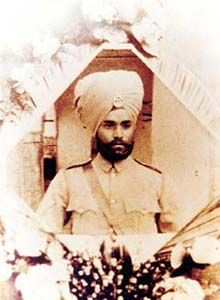
Manta Singh was born in the Punjab, northern India, in 1907. After finishing school, he joined the 2nd Sikh Royal Infantry. By August 1914, when the German army invaded Belgium and France, Manta held the rank of Subedar, and his regiment was part of the Indian Expeditionary Force sent to France.
In March 1915 the Allies attacked Neuve-Chapelle and broke through the German front line. On the first day of the battle, British and Indian troops captured the town. Then the Germans counter-attacked with 16,000 reinforcements. In three days’ fighting, the British and Indian troops suffered 13,000 casualties. The Allies’ ammunition ran out, and the troops had to retreat. About 20 per cent of the Indian contingent (5,021 Indian soldiers) were killed in heavy fighting, and Manta Singh was injured in action after helping to save the life of an injured officer, Captain Henderson. (In the Second World War, the sons of both of these men served side by side and became lifelong friends.)
Manta Singh was sent back to England, to a hospital in Brighton. The doctors told him that he would have to lose both his legs, as they had become infected with gangrene. Manta refused to think about going back to India with no legs. Unfortunately, he died from blood poisoning a few weeks later. He was cremated in a ghat, according to Sikh beliefs.
In 1993 Manta Singh’s son, Lieutenant Colonel Assa Singh Johal, was part of a delegation of the Undivided Indian Ex-Servicemen’s Association that visited the Indian war memorial at Neuve-Chapelle. Assa Singh said, “It was a moving visit of great sentimental value to us. We were able to remember and pay homage to the fallen in foreign lands.”



